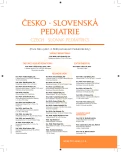Diagnostic and treatment pitfalls of pheochromocytoma in children
Authors:
P. Kunovský 1; Z. Pribilincová 2; A. Kriššáková 1; R. Dinka 1; M. Kováč 1; J. Krbaťa 3; J. Malina 4; J. Babala 5
Authors‘ workplace:
Národný ústav srdcových a cievnych chorôb, a. s., Detské kardiocentrum, JIS kardiologického oddelenia, Bratislava, primár MUDr. P. Kunovský, PhD., MBA
1; 2. detská klinika DFNsP a LFUK, Bratislava, prednosta prof. MUDr. L. Kovács, DrSc., MPH
2; Rádiologické oddelenie DFNsP, Bratislava, primár MUDr. D. Haviar
3; Klinika onkologickej chirurgie OUSA a LFUK, Onkologický ústav svätej Alžbety, s. r. o., Bratislava, prednosta prof. MUDr. Š. Durdík, PhD., MHA
4; Klinika detskej chirurgie DFNsP a LFUK, Bratislava, prednosta doc. MUDr. J. Trnka, CSc.
5
Published in:
Čes-slov Pediat 2015; 70 (4): 249-254.
Category:
Education
Overview
Pheochromocytomas and paragangliomas (PHEO/PGL) are neuroendocrine tumors that arise from sympathetic and parasympathetic paraganglia. PHEO presents most frequently by permanent or paroxysmal hypertension, headache, sweating, palpitations and anxiety. Diagnosis is based on typical clinical presentation confirmed by biochemical measurement of plasma metanephrines and normetanephrines with the sensitivity almost up to 100% being the test of choice for the diagnosis of PHEO. The morphological test of choice is either computed tomography or magnetic resonance imaging, which have similar diagnostic sensitivities of the abdomen and pelvis. Definitive and causal treatment is by surgical resection and the procedure of choice for most PHEO is laparoscopic adrenalectomy. Main goal of preoperative management is normalization of blood pressure, heart rate, reinstitution of normovolemia and prevention of catecholamine „storm“ and its effects on cardiovascular system during manipulation with tumor in the course of operation. Authors suggest as initial treatment in hypertensive crisis intravenous urapidil and in case of persisting tachycardia the combination with metoprolol after adequate time delay to achieve satisfactory alpha blockade and/or calcium channel blocker amlodipine.
The aim of the report is to draw attention to difficulties in diagnostics of PHEO and to outline current approaches to preoperative management to prevent severe adverse events of children suffering from this tumor. The pediatric provider should be able to recognize and screen for such tumors, particularly in the context of a known genetic predisposition (von Hippel-Lindau syndrome, MEN type 2, neurofibromatosis type 1, and paragangliomas). The clinical presentation of PHEO might be sometime atypical so most important part of correct diagnosis depends on having a clinical suspicion for it and then confirming the diagnosis biochemically.
Key words:
pheochromocytoma, hypertensive crisis, von Hippel-Lindau syndrome, urapidil
Sources
1. Goodman MT, Gurney JG, Smith MA, et al. Sympathetic nervous system tumors. In: Ries LAG, Smith MA, Gurney JG, et al. Cancer Incidence and Survival among Children and Adolescents: United States SEER Program 1975–1995. NIH Pub. No. 99-4649. Bethesda: MD, 1999: 65–72.
2. Waguespack SG, Rich T, Grubbs E, et al. A current review of the etiology, diagnosis, and treatment of pediatric pheochromocytoma and paraganglioma. J Clin Endocrinol Metab 95: 2010: 2023–2037.
3. Vuguin PM. Pediatric Pheochromocytoma:2013. http://emedicine.medscape.com/article/988683-overview.
4. Musil Z, Vícha A, Zelinka T, et al. Hereditární feochromocytóm a paraganglióm. Klin Onkol 2012; 25: 21–26.
5. Neumann HP, Bausch B, McWhinney SR, et al. Germ-line mutations in nonsyndromic pheochromocytoma. N Engl J Med 2002; 346: 1459–1466.
6. Widimsky J Jr, Zelinka T, Petrak O, et al. Pheochromocytoma: diagnosis and treatment. Čas Lék čes 2009; 148 (8): 365–369.
7. Widimsky J Jr, Zelinka T, Petrak O, et al. Diagnostic and therapeutic procedures in pheochromocytoma: current trends. Vnitr Lek 2007; 53 (4): 428–433.
8. Kosmálová V. Feochromcytóm. Vask med 2013; 5 (2): 70–73.
9. Yu R, Nissen NN, Chopra P, et al. Diagnosis and treatment of pheochromocytoma in an academic hospital from 1997 to 2007. Am J Med 2009; 122 (1): 85–95.
10. Lenders JW, Pacak K, Walther MM, et al. Biochemical diagnosis of pheochromocytoma: which test is best? JAMA 2002; 287: 1427–1434.
11. Eisenhofer G, Goldstein DS, Walther MM, et al. Biochemical diagnosis of pheochromocytoma: how to distinguish true- from false-positive test results. J Clin Endocrinol Metab 2003; 88: 2656–2666.
12. Pacak K, Eisenhofer G, Ahlman H, et al. Pheochromocytoma: recommendations for clinical practice from the First International Symposium. Nat Clin Pract Endocrinol Metab 2005; 3: 92–102.
13. Janota T, Zelinka T. Urapidil, lék první volby pro těžké hypertenzní stavy. Interv Akut Kardiol 2013; 12 (3): 150–152.
14. Ludwig AD, Feig DI, Brandt ML, et al. Recent advances in the diagnosis and treatment of pheochromocytoma in children. Am J Surg 2007; 194: 792–796.
15. Asari R, Scheuba C, Kaczirek K, et al. Estimated risk of pheochromocytoma recurrence after adrenal-sparing surgery in patients with multiple endocrine neoplasia type 2A. Arch Surg 2006; 141: 1199–1205.
16. Reddy VS, O’Neill JA Jr, Holcomb GW 3rd, et al. Twenty-five-year surgical experience with pheochromocytoma in children. Am Surg 2000; 66: 1085–1091.
17. Coutant R, Pein F, Adamsbaum C, et al. Prognosis of children with malignant pheochromocytoma. Report of 2 cases and review of the literature. Horm Res 1999; 52: 145–149.
18. Ross JH. Pheochromocytoma. Special consideration in children. Urol Clin North Am 2000; 27 (3): 393–402.
19. Amar L, Servais A, Gimenez-Roqueplo AP, et al. Year of diagnosis, features at presentation, and risk of recurrence in patients with pheochromocytoma or secreting paraganglioma. J Clin Endocrinol Metab 2005; 90 (4): 2110–2116.
20. Kovács L. Meranie krvného tlaku a hypertenzia u detí. Pediatr prax 2007; 1: 5–11.
21. Ilias I, Pacak K. Current approaches and recommended algorithm for the diagnostic localization of pheochromocytoma. J Clin Endocrinol Metab 2004; 89 (2): 479–491.
Labels
Neonatology Paediatrics General practitioner for children and adolescentsArticle was published in
Czech-Slovak Pediatrics

2015 Issue 4
Most read in this issue
- Enzyme replacement therapy in lysosomal storage diseases
- Diagnostic and treatment pitfalls of pheochromocytoma in children
- Gastrointestinal adverse effects of methotrexate in patients with juvenile idiopathic arthritis – are they properly assessed?
- Possibilities of reducing pain in children on the psychosocial level
